Electronic dampeners? Costly repair
#17
Lexus Fanatic
Adaptive suspensions allow for softer dampening when driving in a straight line and allow for fraction of a second firmer dampening when cornering. It allows them to not have to make a trade off in ride for secure handling.
Also, there’s no noise from the drivetrain in an LS, RWD cars are not “louder” than FWD cars. The LS is definitely quieter than the ES. ES this generation does ride softer than this generation LS.
#18
Intermediate
Thread Starter
Drive them both, it absolutely will. I had a GS with AVS and compared to the regular suspension GS there was a notable difference in the ride. My LS has it too but also has air suspension. I had an LS with standard suspension and the ride difference is notable also.
Adaptive suspensions allow for softer dampening when driving in a straight line and allow for fraction of a second firmer dampening when cornering. It allows them to not have to make a trade off in ride for secure handling.
Also, there’s no noise from the drivetrain in an LS, RWD cars are not “louder” than FWD cars. The LS is definitely quieter than the ES. ES this generation does ride softer than this generation LS.
Adaptive suspensions allow for softer dampening when driving in a straight line and allow for fraction of a second firmer dampening when cornering. It allows them to not have to make a trade off in ride for secure handling.
Also, there’s no noise from the drivetrain in an LS, RWD cars are not “louder” than FWD cars. The LS is definitely quieter than the ES. ES this generation does ride softer than this generation LS.
#19
Lexus Fanatic
#20
That's not my experience with my LS500. It's as quiet as my previous LS460s. It has active noise cancellation that the LS460s do not have. Now if you put it into Sprt+ mode then some amount of noise is simulated in the cabin.
#21
Lexus Fanatic
I also found the 500 as quiet as the 460, rides firmer and tighter inside though
#23
Lexus Fanatic
#24
Lexus Test Driver
Is this the LS forum or ES?

The following users liked this post:
SW17LS (04-19-19)
#25
Lead Lap
#26
Lexus Test Driver
Considering all of the very different vehicles that he has been looking at and comparing, including at least, but not limited to, 3 generations of the ES, 3 generations of the LS, and at least 1 generation of the GS, I can only imagine the reaction of the sales staffs at the dealers when they see him starting to walk into their showrooms. I'll bet that they can't move fast enough to try to find somewhere to hide.
#28
Theoretically, yes, but in practice, we must test drive, because there are many other factors at play.
Likewise, electronic variable dampers.
Theoretically, electronic variable valve damping is just that - the valve damping is variable.
Variable dampers will decrease/increase the damping rate, which decreases/increases the suspension control, to decrease/increase the floatiness.
The dampers feel floaty due to a low frequency of oscillation.
Firm dampers feel firm, due to a high frequency of vertical oscillation.
Please note that electronic variable valve damping can NOT increase the stiffness of the suspension; in other words, electronic dampers cannot decrease body roll to reduce weight transfer to the outside wheels.
Dampers merely give ride control, to prevent excessive floatiness, but too much control is a very high frequency of vertical oscillation which is tiring to the occupants.
Theoretically, electronic variable dampers ride better than fixed valve damping, however in practice, the vehicle must be test driven, because the valving will automatically reduce in size as speed rises for a much less floatier ride at speed, and this may be perceived as less comfort at high speeds.
Even if you don't use electronic variable valve dampers [nee shock absorbers], the piston/cylinder wall inside ALL dampers [shock absorbers] will wear out and need replacing anyway.
Electronic variable valve dampers [shock absorbers] only cost a little more than conventional dampers with a fixed damping rate.
All dampers wear with age and need replacement in pairs; normally either the front pair, or the back pair.
There is no extra labour involved in replacing electronic dampers; just attach the module containing the motor which rotates the arm at the top of the damper to vary the valve opening.
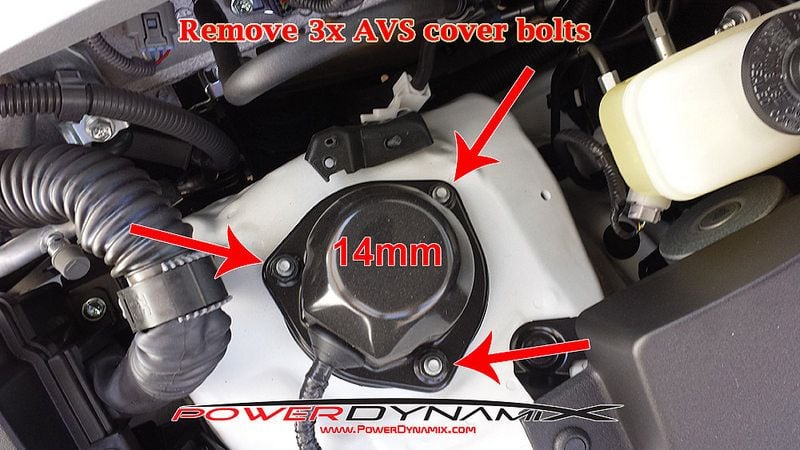


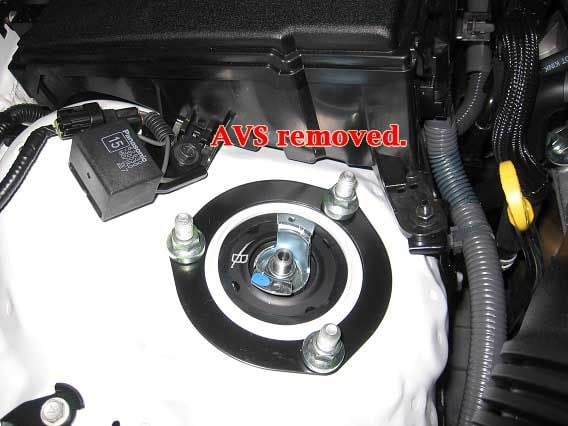

Last edited by peteharvey; 04-19-19 at 10:18 PM.
#29
Does a long wheelbase car necessarily ride better than a shorter wheelbase car?
Theoretically, yes, but in practice, we must test drive, because there are many other factors at play.
Likewise, electronic variable dampers.
Theoretically, electronic variable valve damping is just that - the valve damping is variable.
Variable dampers will decrease/increase the damping rate, which decreases/increases the suspension control, to decrease/increase the floatiness.
The dampers feel floaty due to a low frequency of oscillation.
Firm dampers feel firm, due to a high frequency of vertical oscillation.
Please note that electronic variable valve damping can NOT increase the stiffness of the suspension; in other words, electronic dampers cannot decrease body roll to reduce weight transfer to the outside wheels.
Dampers merely give ride control, to prevent excessive floatiness, but too much control is a very high frequency of vertical oscillation which is tiring to the occupants.
Theoretically, electronic variable dampers ride better than fixed valve damping, however in practice, the vehicle must be test driven, because the valving will automatically reduce in size as speed rises for a much less floatier ride at speed, and this may be perceived as less comfort at high speeds.
Even if you don't use electronic variable valve dampers [nee shock absorbers], the piston/cylinder wall inside ALL dampers [shock absorbers] will wear out and need replacing anyway.
Electronic variable valve dampers [shock absorbers] only cost a little more than conventional dampers with a fixed damping rate.
All dampers wear with age and need replacement in pairs; normally either the front pair, or the back pair.
There is no extra labour involved in replacing electronic dampers; just attach the module containing the motor which rotates the arm at the top of the damper to vary the valve opening.
Theoretically, yes, but in practice, we must test drive, because there are many other factors at play.
Likewise, electronic variable dampers.
Theoretically, electronic variable valve damping is just that - the valve damping is variable.
Variable dampers will decrease/increase the damping rate, which decreases/increases the suspension control, to decrease/increase the floatiness.
The dampers feel floaty due to a low frequency of oscillation.
Firm dampers feel firm, due to a high frequency of vertical oscillation.
Please note that electronic variable valve damping can NOT increase the stiffness of the suspension; in other words, electronic dampers cannot decrease body roll to reduce weight transfer to the outside wheels.
Dampers merely give ride control, to prevent excessive floatiness, but too much control is a very high frequency of vertical oscillation which is tiring to the occupants.
Theoretically, electronic variable dampers ride better than fixed valve damping, however in practice, the vehicle must be test driven, because the valving will automatically reduce in size as speed rises for a much less floatier ride at speed, and this may be perceived as less comfort at high speeds.
Even if you don't use electronic variable valve dampers [nee shock absorbers], the piston/cylinder wall inside ALL dampers [shock absorbers] will wear out and need replacing anyway.
Electronic variable valve dampers [shock absorbers] only cost a little more than conventional dampers with a fixed damping rate.
All dampers wear with age and need replacement in pairs; normally either the front pair, or the back pair.
There is no extra labour involved in replacing electronic dampers; just attach the module containing the motor which rotates the arm at the top of the damper to vary the valve opening.

Also, most automotive companies/journalists/drivers I keep up with will say "electronic" shocks will reduce body roll by stiffening the suspension. They do not eliminate weight transfer, as physics is undefeatable, but they most definitely reduce body roll by stiffening when needed. GM, who first developed the 'active' shocks, advertises their magnetic shocks as a way to stiffen suspension when the sensors detect body roll. Lexus also advertises that their active suspension reduces body roll.
#30
I'm not sure about your experience, but in my experience "electronic" shocks definitely increase the stiffness of the suspension and decreased body roll. I could take a long sweeping turn in my Corvette in Tour mode (softest shock setting) and experience body roll. The same turn at the same speed in Track mode (firmest shock setting) would eliminate the body roll. I took the same sweeping turn every Friday for 3 years so I had plenty of opportunities to compare. The same can be done in the ES, though it requires much lower speeds for the body roll 
Also, most automotive companies/journalists/drivers I keep up with will say "electronic" shocks will reduce body roll by stiffening the suspension. They do not eliminate weight transfer, as physics is undefeatable, but they most definitely reduce body roll by stiffening when needed. GM, who first developed the 'active' shocks, advertises their magnetic shocks as a way to stiffen suspension when the sensors detect body roll. Lexus also advertises that their active suspension reduces body roll.

Also, most automotive companies/journalists/drivers I keep up with will say "electronic" shocks will reduce body roll by stiffening the suspension. They do not eliminate weight transfer, as physics is undefeatable, but they most definitely reduce body roll by stiffening when needed. GM, who first developed the 'active' shocks, advertises their magnetic shocks as a way to stiffen suspension when the sensors detect body roll. Lexus also advertises that their active suspension reduces body roll.
After the vehicle hits a bump, it is actually the springs that absorb the shock, hence the term shock absorber is actually a misnomer, and is more correctly called a damper.
After hitting a bump, a vehicle with no shock absorber/damper will continue to bob up and down - floating forever.
The upward movement of the wheel compresses the spring where the kinetic energy of motion is stored as potential energy inside the spring.
This stored potential energy is then released as kinetic energy on rebound.
This natural floating movement to dissipate mechanical energy is measured in cycles called Hertz.
The lower the frequency of vertical oscillation, the more the vehicle feels floaty, and because the movement is slow, it is comfortable and not tiring.
The higher the frequency of vertical oscillation, the more quickly it bounces up/down, but this movement is tiring and uncomfortable.
Due to internal friction within the molecules of the steel spring, a coil spring with NO shock absorber/damper - the bobbing up/down floaty motion will eventually naturally come to a stand still.
The purpose of the shock absorber/damper is to force oil through controlled valves, as the piston oscillates up/down through the shock absorber/damper cylinder.
As oil is forced through the valves, the mechanical energy is turned into thermal energy, and dissipated into the atmosphere.
Unlike the coil spring, mechanical kinetic energy is NOT stored as potential energy inside the shock absorber.
The valves used inside the shock absorber/damper are clever "one-way" valves which open wide for unimpeded oil flow on compression, but heavily restrict the flow of oil on "rebound".
The valve opening can be fixed.
Aftermarket adjustable valve shocks are available where the adjustment is via a screw driver or Allen key.
Automatic electronic variable valve shock absorbers/dampers have been used by Japanese cars since the early 1980's.
The standard shock absorber is the twin tube shock absorber design with both outer and inner tubes.
The newer monotube design helps to release heat into the atmosphere more quickly.
By rapidly arresting the natural floating movements, the tires stay planted to the ground to maximize grip.
Vehicles with the natural floating movements, not only the vehicle itself, but also the tires bob up and down, compromising the grip.
Over time, it is the piston/cylinder and seals - which age, requiring shock absorbers to be replaced, especially in pairs.
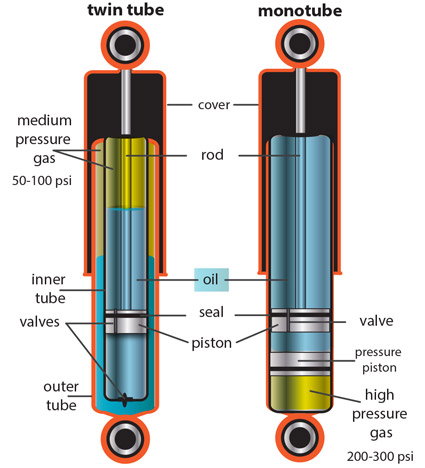
To limit body roll to limit weight transfer to the outside wheels, we must:
1) Control body weight. The lighter the weight, the less the body roll.
2) Use as wide a track as possible to increase the minimum leverage required for inside wheel lift-off resulting in 2-wheeling - which greatly diminishes maximum cornering grip.
3) Lower the Center of Gravity by body structural design.
4) Raise the Roll Centers by suspension linkage design.
5) Use firm springs.
6) Use firm roll bars.
If an anti-roll bar was 100% rigid, the vehicle would now have 100% NON-independent suspension.
A roll bar turns the vehicle into a "semi" independent suspension.
Only a vehicle with NO roll bar whatsoever, would have true 100% fully independent suspension.
Thus, roll bars turn a fully independent suspension vehicle, into a semi-independent or a non-independent suspension - depending on the level of roll stiffness.
In a non-independent suspension vehicle, as the left wheel rises, the right wheel rises too, and vice versa.
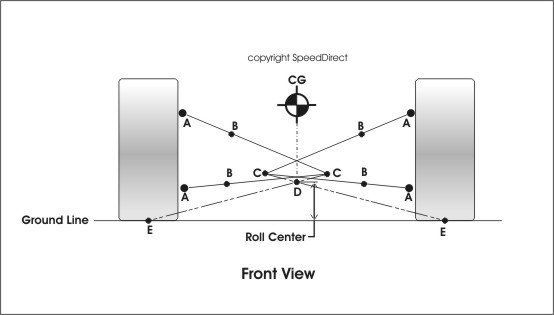
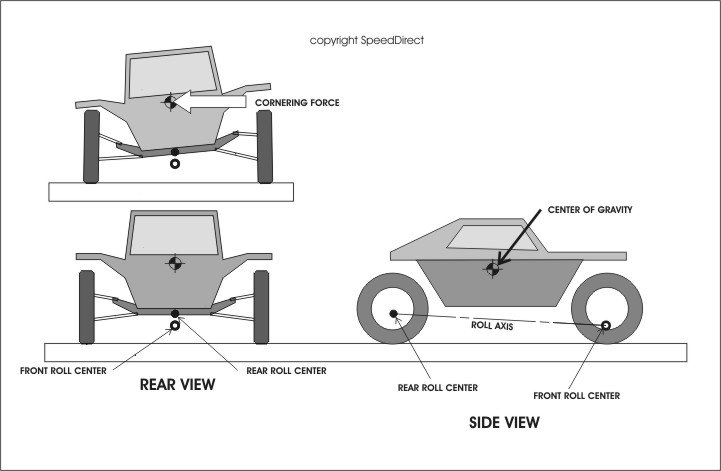
Journalists?
Be careful when reading journalist articles or watching videos; unfortunately a number of journalists don't have sound technical knowledge of motor vehicles.
GM Magnetic Ride?
Lexus Active Suspension?
Would you be able to provide a link to where GM's Magnetic Ride and Lexus Active Suspension claims?
Often it is a case of the reader interpretation.
When they say stiffen, they don't mean stiffening the coils/roll bars, but stiffening the "float control", or what some term "ride control", or body control.
Shock absorbers/dampers are all about "control".
For example, on Car Chat there is a thread here where Jill & Steve are debating about the new TNGA platform.
https://www.clublexus.com/forums/car...l#post10492464
Jill thinks that TNGA is responsible for making the new Corolla more compact inside etc.
On the other hand, Steve & Mr Sulu correctly pointed out that Modular Global Architecture Platforms have nothing to do with making the new Corolla smaller inside; it is actually the dimensions & styling of the new Corolla that makes it more compact inside.
The old 2012-18 Corolla was always sold as a 2012-18 Auris Hatch in Europe, and a 2012-18 Corolla Sedan.
Now, the new 2018-24 Corolla comes in either sedan or hatch.
The sedan and hatch have different wheelbase lengths, and different heights.
Hence it is NOT the modular global architecture platform that makes new Corolla more compact inside.
However, we can understand where Jill is coming from.
TNGA in C, K, N and L is just the name of the platform.
C replaces the old New MC platform used in Corolla etc.
K replaces the old K platform used in Camry etc.
N replaces the old New N platform used in IS/Crown/GS etc.
While L replaces the old N platform used in old LS.
TNGA-C/K/N/L is only a name.
TGNGA uses Modular Global Architecture so that more parts can be shared to speed up design/manufacture, and to lower costs, such that more different vehicles can be assembled on the same line.
In the Toyota website below, we can understand why Jill has come to think that TNGA is also responsible for:
- Hot stamping
- Laser screw welding
- Enhanced visibility and legroom
- Promotes more athletic/aggressive styling
- Lower and wider stance etc.
It is the way the marketing department's staff type the script on the website that can mislead the reader...

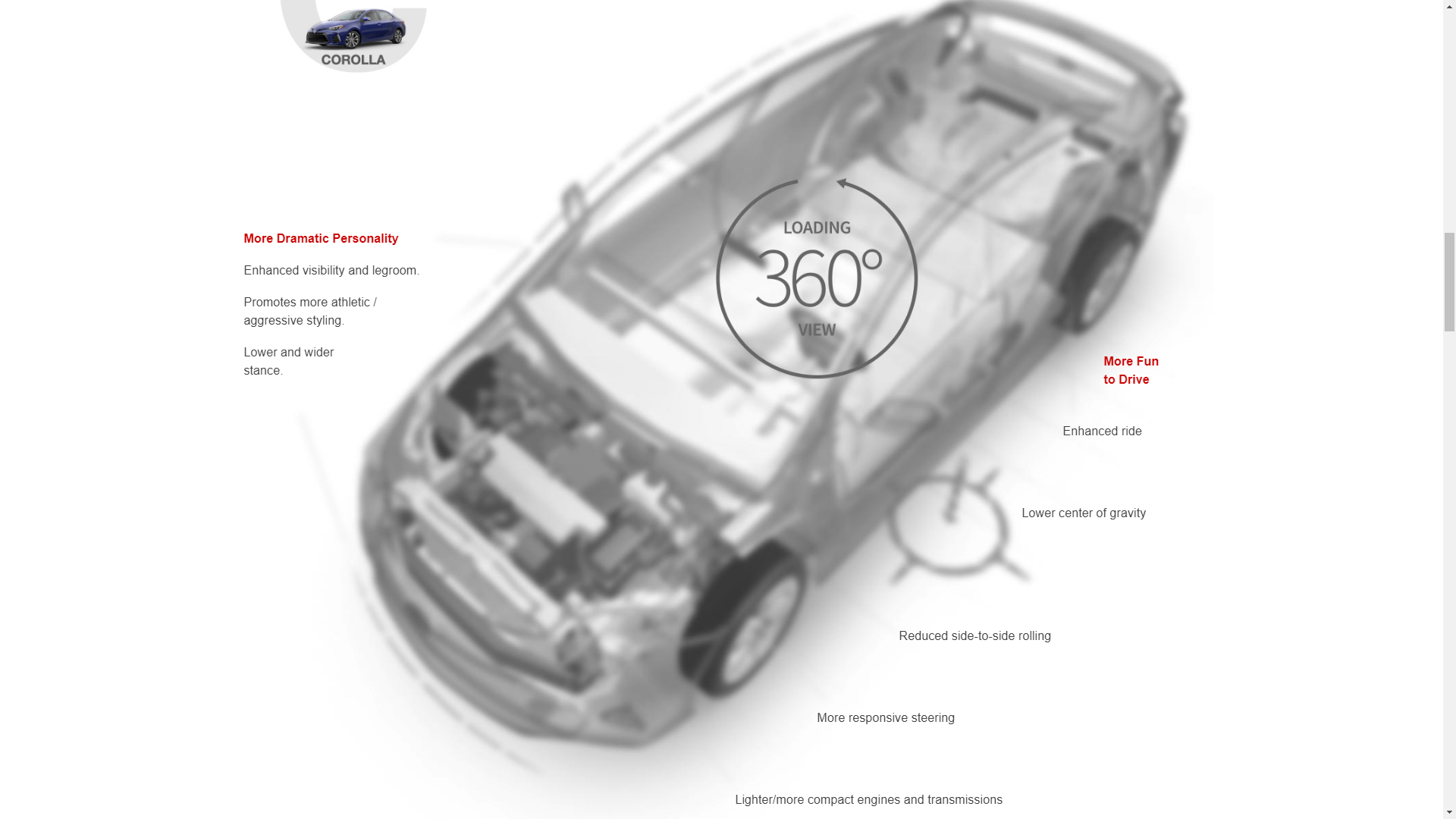
Last edited by peteharvey; 04-20-19 at 02:00 PM.
The following users liked this post:
hlu (05-09-20)


